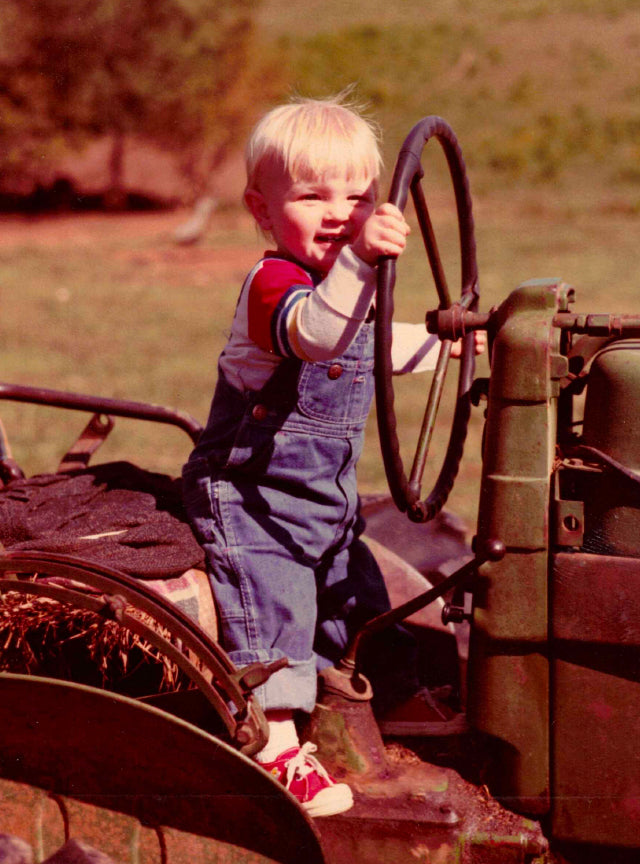
2) Family Farms – Yesterday and Today
Share
My name is George Alexander “Alex” Miller, the same as my dad’s and his dad’s. I farm the land my grandfather bought over 100 years ago, and on which my father worked his whole life.
George Sr. was a sharecropper who could only scrape together enough money to buy a worn-out, badly eroded hillside farm. At the time, a neighbor pulled him aside and warned him he would never make a go of it – that the farm was too far gone. Another neighbor took pity on him and brought him a load of hay because it was clear he was going to need it!
But he not only managed to survive, he thrived. He and his first and second wives raised 10 children on the farm and lived a relatively comfortable life. For example, during the Great Depression, the family owned two Model T’s!
But, one hundred years later, that same farm could be threatened with extinction. How can that be? After 100 years of “progress” in equipment, fertilizer, herbicides, pesticides, and improved livestock and crop genetics, how can a farm that thrived in 1920, struggle in 2020? It’s basic accounting: revenues are down and costs are up.
In 1919, the price of beef cattle, our primary product, was exactly the same as today’s prices, adjusted for inflation. In today’s dollars, steers sold back then brought $1.20 a pound “on the hoof” (alive). The last steers we sold today brought $1.20 a pound on the hoof: exactly the same.
Are you surprised to hear that inflation-adjusted cattle prices have not risen? It’s easy to understand why. The price you pay for beef is much higher, but the price farmers are paid for cattle is not. Consumers pay $4 more a pound for steaks today than they did 25 years ago, but farmers only get 50¢ more a pound for the steer that produced those steaks.
In 1950, when my dad was running our farm, he could expect nearly 50¢ of every dollar spent on food in the United States would go to farmers. Today, farmers can expect less than 11¢ of that food dollar.
Meanwhile, the cost of farming has sky-rocketed. George Sr. paid 25¢ a gallon for gasoline in actual dollars, and after adjusting for inflation, his fuel costs were 40% less than ours. His fertilizer (which he really didn’t start using until after World War II) cost about 1/8 what we pay today. But the really big difference was his investment in land. Adjusting for inflation, he could buy farmland for under $200 per acre, but today, that same land would cost $6,000 per acre – 30 times more!
Between decreased revenues and increased costs, the situation our family faces today is dramatically different from that our ancestors faced. One hundred years ago, Tennessee farmers expected to pay off the mortgages on their farm land in five years. Today, the latest economic models (from the University of Tennessee Institute of Agriculture) forecast cattle farmers in Tennessee will LOSE $276 for every cow-calf pair they own.
So why does anyone farm? Perhaps it’s the lifestyle? Do they imagine the land will appreciate in value and become a good investment eventually? It’s difficult to say why any one individual would choose to farm today, but it’s pretty obvious that no one farms because it’s an easy way to make a living!
Consequently, our Tennessee farms are disappearing. Before the Civil War, Tennessee was arguably one of the most important agricultural states in the nation – we were the top-producing state on many common agricultural goods. Consequently, in my grandfather’s time, there were approximately 260,000 farms in Tennessee. Today there are 60,000.
In future blog posts, I plan to address this conundrum and what I believe is required to save family farms in Tennessee. I’ll describe how we all have roles to play: 1) farmers need to return to lower cost, more sustainable production, and 2) consumers need to shop LOCALLY.
At Lick Skillet Farm, we are 100% committed to saving our family farm, and seeing it last another 100 years. Along the way, I will share with you our story, our successes, and our failures. I will also encourage you to play your own, absolutely critical, role: allowing my family to provide your family with healthy, compassionately-raised protein.
I look forward to our conversation, and to being your farmer,
Alex Miller
